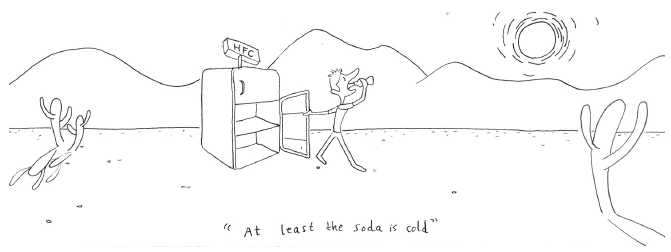Trying to stop human-caused climate change is like trying to stop a speeding bus; you need to slow it down first. Carbon dioxide already in the atmosphere will linger for hundreds of years, rendering the considerable attention focused on CO2 emissions somewhat misplaced – especially since there’s another way to slow climate change with a more immediate effect. Pollutants such as methane, black carbon, tropospheric ozone (not to be confused with the beneficial ozone layer), and hydrofluorocarbons (HFCs) exist in the atmosphere anywhere from a few days, in the case of black carbon, to at most a few years, in the case of HFCs. These four pollutants, known collectively as short-lived climate pollutants (SLCPs), account for almost half of all warming in the atmosphere. Once their emissions are curbed, the proverbial bus would slow more quickly than it would through a short-term emphasis on carbon. Policies to control one particular type of SLCP, HFCs, could easily benefit from such political maneuvering.
The solution would depend on the Montreal Protocol, a treaty signed in 1989 aimed at phasing out chlorofluorocarbons (CFCs) completely. In 1974, researchers found that CFCs, one of the world’s most used refrigerants, depleted the ozone and warmed the atmosphere five thousand times more than CO2. To date, the Montreal Protocol, which grew out of that finding, has eliminated more CO2 equivalent emissions than any other event or policy in human history and exists as a living document open to further expansion.
In the wake of the Montreal Protocol’s creation, the use of HFCs drastically increased. While HFCs don’t harm the ozone layer, they do warm the atmosphere over a thousand times more than carbon dioxide does a hundred-year period. Due to increased demand for air conditioning in countries like India and Brazil, HFCs are some of the world’s fastest growing refrigerants and pollutants. Unmitigated, they would account for the equivalent of almost 9 billion tons of CO2 by 2050. To put that in perspective, 9 billion tons amounts to the current yearly combined emissions of the United States and the European Union. HFCs are an imminent threat, but the Montreal Protocol may serve as a welcome tool to combat their nefarious effects.
In November 2015, at the 27th Meeting of the Parties to the Montreal Protocol, the attendees agreed to “work within the Montreal Protocol to [write] an HFC amendment in 2016,” but failed to do so. India, Saudi Arabia, and Kuwait remain hesitant to abandon HFCs due to their immense need for cheap and efficient air-conditioning. In Saudi Arabia, for example, 70 percent of electricity consumption goes toward air-conditioning. Ironically, resistance to an HFC phase-out would do more harm in the long run. After all, these three countries would require more air-conditioning in a warming world; cutting HFCs would be a first step toward cooling the planet and hopefully indirectly reducing dependence on air-conditioning.
Durwood Zaelke, the head of the Institute for Governance and Sustainable Development, said in an interview with the Brown Political Review that “the deciding countries will be the Gulf States, led by Saudi Arabia and Kuwait…and they have one legitimate technical question: Will the new alternatives [to HFCs] work as well in high ambient temperatures?” To answer that question, the Department of Energy commissioned a study from Oak Ridge National Laboratory, which found that the alternatives were inferior to HFCs under “soft-optimization,” the act of replacing the coolant, not the machine. However, under “hard-optimization,” designing an air-conditioner specifically for alternatives, the HFC replacements could outperform existing technologies. This finding reaffirms the need for sustained contributions from developed countries toward a multilateral fund that will aid countries in transitioning from their old, less-efficient HFC air-conditioners to new low emission products.
But any amendment to the Montreal Protocol must adhere to the formula that made it effective nearly 30 years ago. Under the treaty, developed countries contributed to a $2.5 billion multilateral fund to give developing countries ample resources to phase out CFCs. However, the Montreal Protocol’s key to success came from big businesses that developing and producing CFC replacements. An HFC amendment needs to commit funding from developed nations to ensure that less industrialized countries can pursue sustainable policies and work with, not against, businesses that will profit from new technology that negates the need for HFCs.
Creating this new technology isn’t entirely unfeasible; in fact, it’s already been developed. Coca-Cola and Pepsi have already replaced HFCs in all new vending machines using DuPont’s technologies, unsurprising given that DuPont invented CFCs decades ago. A more environmentally friendly alternative to HFCs exists in every sector in which they are used, and they’re almost universally more energy-efficient. One study found that a transition away from HFCs would save an amount of energy equal to the production of almost 3,000 coal power plants by 2050. The primary obstacle to further adoption of these efficient and sustainable products is institutional inertia. After the initial costs of buying new non-HFC designed coolers, the energy savings would reduce both the cost of cooling and the negative externalities involved in polluting the Earth.
The two “levers” for climate protection – carbon emissions and SLCPs – must both be pushed, or there will be no hope of avoiding the two-degree Celsius temperature limit, much less the 1.5 degree limit negotiated at the Paris Climate Conference in December 2015. Policies to reduce SLCPs are, relatively speaking, politically and economically painless, but even so, they can only slow down the bus.
Art by Soraya Ferdman
